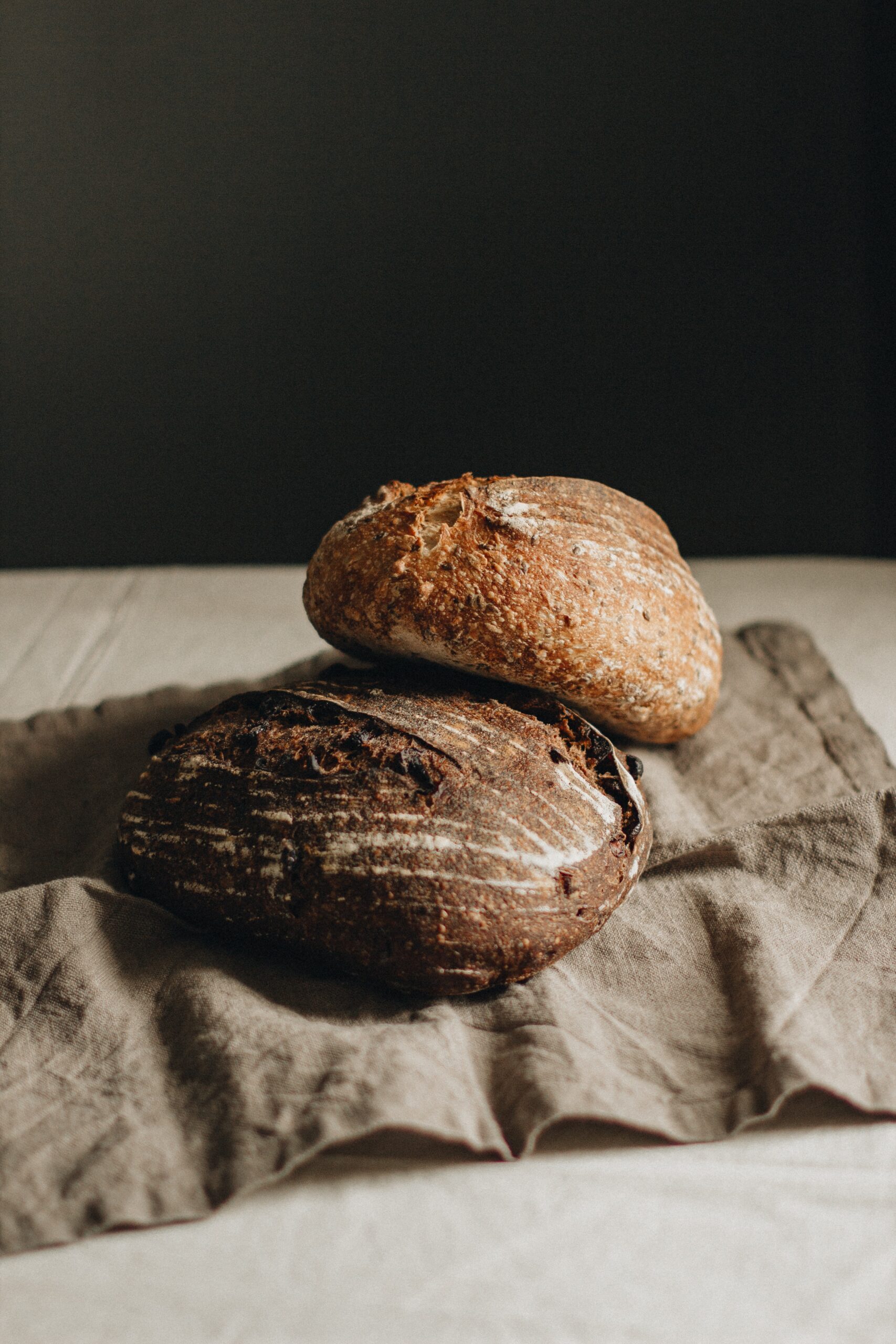
Sourdough bread is a delicious and versatile bread that can be enjoyed in many ways, from toast to sandwiches and everything in between. If you have recently been baking sourdough bread, you may be wondering how to store it properly to keep it fresh for longer. Here are some tips and tricks to help you store your freshly baked sourdough bread.
How To Store Sourdough Bread for Maximum Shelf Life
How to Store Sourdough at Room Temperature
One of the most common ways to store sourdough bread is at room temperature. This method is best for those who plan on consuming the bread within a day or two. To store sourdough bread at room temperature, you can simply place it in a bread box or wrap it in a tea towel and place it on your kitchen counter. This method helps to keep the crust crispy while preventing the bread from drying out too quickly.
How to Store Sourdough in a Plastic Bag
If you want to store sourdough bread for a longer period of time, you may want to consider using a plastic bag. While not the best option for the environment, plastic bags can help to keep your bread fresh for several days. Simply place the bread in a plastic bag and store it at room temperature. However, be sure to use a bag that is large enough to accommodate the bread without squishing it.
How to Store Sourdough in a Paper Bag
An eco-friendly alternative to plastic bags is a paper bag. A paper bag helps to keep the crust crispy while also allowing the bread to breathe. To store sourdough bread in a paper bag, simply place the bread in the bag and fold the top over to seal it. You can then store the bag at room temperature for up to three days.
How to Store Sourdough in a Bread Bag
Another option for storing sourdough bread is a bread bag. A bread bag is a specially designed bag that helps to keep the bread fresh by allowing it to breathe. You can purchase a bread bag online or at your local kitchen supply store. Simply place the bread in the bag and store it at room temperature for up to five days.
How to Store Sourdough in a Stainless Steel Bread Bin
If you prefer a more durable storage option, you can consider using a stainless steel bread bin. A bread bin helps to keep the bread fresh by keeping out air and moisture. Simply place the bread in the bin and store it at room temperature. A bread bin is also a stylish addition to your kitchen decor.
How to Store Sourdough in a Beeswax Wrap
For an eco-friendly alternative to plastic wrap, you can consider using beeswax wrap. Beeswax wrap is made from cotton fabric coated in beeswax, and it can be used to wrap and store sourdough bread. Simply wrap the bread in the beeswax wrap and store it at room temperature for up to three days.

Can Sourdough Bread Be Frozen?
Yes, sourdough bread can be frozen. In fact, freezing is a great way to extend the shelf life of sourdough bread and keep it fresh for longer. Freezing sourdough bread can also be a useful way to manage your bread supply, especially if you like to bake large batches of bread or have leftover loaves that you want to save for later.
When frozen properly, sourdough bread retains its flavour and texture very well.
The Benefits of Freezing Sourdough
Freezing sourdough bread offers several benefits that make it a convenient option for sourdough enthusiasts. Here are some advantages of freezing sourdough:
- Convenience and Flexibility: Freezing sourdough allows you to have fresh bread on demand. You can bake a larger batch of dough, freeze the portions you don’t need immediately, and thaw and bake them later. This flexibility ensures you always have freshly baked sourdough bread available, even on busy days.
- Extended Shelf Life: By freezing sourdough, you can significantly extend its shelf life. While fresh sourdough bread typically stays fresh for a few days, freezing it preserves its quality for several weeks. This helps reduce food waste and allows you to enjoy homemade bread over an extended period.
- Time-saving: Sourdough bread-making can be a time-consuming process that requires patience and planning. Freezing the dough allows you to prepare it in advance, saving you time on the day you want to bake. With the frozen dough, you can skip the initial fermentation and shaping steps, streamlining the baking process.
- Flavour Development: Freezing sourdough bread dough can contribute to the development of complex flavours. The extended fermentation that occurs during the freezing process can enhance the sourdough’s flavour profile, resulting in a more pronounced and nuanced taste when the dough is baked.
- Improved Texture: Freezing sourdough dough can improve the texture of the baked bread. The freezing and thawing process allows for further gluten development, which can result in a more desirable crumb structure and better oven spring. This can lead to a lighter and airier texture in the final baked bread.
- Reduction of Starter Maintenance: If you have a sourdough starter that requires regular feeding and maintenance, freezing sourdough bread dough can provide a break from this routine. By freezing portions of dough, you can preserve a portion of your starter while having the option to bake bread when desired.
- Decreased Waste: Freezing sourdough bread dough helps reduce waste by allowing you to utilize excess dough or leftovers effectively. Instead of discarding unused dough or stale bread, you can freeze them for future use. This way, you can fully enjoy your sourdough without worrying about wasting any of it.
With these benefits, freezing sourdough bread becomes a valuable tool in managing your baking schedule, reducing waste, and ensuring you always have delicious, homemade sourdough bread available.
Can you freeze sourdough bread dough?
Yes, you can freeze sourdough bread dough to be baked at a later time. Freezing the dough allows you to prepare it in advance and have freshly baked sourdough bread whenever you desire. Here’s how to freeze sourdough bread dough:
- Prepare the dough: Follow your sourdough bread recipe and complete the initial mixing and fermentation stages.
- Shape the dough: Once the dough has undergone the bulk fermentation and shaping process, shape it into the desired loaf or individual portions.
- Wrap the dough: Place the shaped dough on a baking sheet lined with parchment paper. Cover it loosely with plastic wrap or place it in a freezer bag. Make sure to remove as much air as possible to prevent freezer burn.
- Freeze the dough: Place the wrapped dough in the freezer and allow it to freeze completely. This usually takes a few hours.
- Store the dough: Once the dough is frozen, you can transfer it to a more compact storage option, such as a freezer bag or airtight container. Remember to label the container with the date for reference.
- Thaw and bake the dough: When you’re ready to bake, remove the frozen dough from the freezer. Thaw it in the refrigerator overnight or at room temperature for a few hours until it is fully thawed and doubled in size. Follow your recipe’s instructions for the final proofing and baking process.
It’s important to note that the texture of the bread may be slightly different from bread made with fresh dough. However, freezing sourdough bread dough allows for convenient baking and still results in a delicious homemade loaf. Enjoy the convenience of having homemade sourdough bread at your fingertips by freezing the dough for later use.
Is it better to freeze sourdough before or after baking?
While it is possible to freeze both unbaked sourdough bread dough and fully baked sourdough bread, the recommended approach is to freeze the dough before baking. Freezing sourdough bread dough prior to baking offers several advantages:
- Flexibility: Freezing the dough allows you to have freshly baked bread whenever you desire. You can thaw and bake the dough at your convenience, ensuring you always have a fresh loaf on hand.
- Superior Texture: Freezing the dough before baking helps maintain the quality of the bread’s texture. The fermentation and oven spring occur after the dough is thawed and baked, resulting in a better rise and overall texture compared to freezing fully baked bread.
- Aromas and Flavors: Baking bread from frozen dough releases enticing aromas and enhances the flavours of the sourdough. The fermentation process continues during the final proofing and baking stages, resulting in a more pronounced sourdough flavour profile.
- Longer Storage Time: Freezing the dough before baking allows for a longer storage period. Properly wrapped and stored, sourdough bread dough can be frozen for several weeks, while fully baked bread typically has a shorter shelf life.

How To Freeze Sourdough Bread
Freezing sourdough bread is a great way to extend its shelf life and keep it fresh for a longer period of time. Here’s a step-by-step guide on how to freeze sourdough bread:
- Let the bread cool completely: It’s important to let the entire loaf cool completely before freezing it. This helps to prevent moisture from forming inside the bread which can cause it to become soggy when you thaw it.
- Slice the bread: Slice the bread into portions that you can easily consume in one sitting. This helps to prevent waste and also makes it easier to thaw the bread when you want to eat it.
- Wrap the bread: Wrap each slice or the whole loaf tightly in plastic wrap or aluminum foil. Be sure to wrap it tightly to prevent any air from getting in.
- Place in a freezer bag: Once you’ve wrapped the bread, place it in a freezer bag. Press out as much air as possible before sealing the bag. You can also use a vacuum sealer if you have one.
- Label and date: Label the bag with the date you froze the bread and what it is. This helps you keep track of what’s in your freezer and how long it’s been there.
- Freeze: Place the bag in the freezer and freeze for up to three months.
- Thaw the bread: To thaw the bread, remove it from the freezer and let it sit at room temperature for a few hours. You can also toast the bread straight from the freezer or reheat it in the oven.
Expert Tips:
- If you have a large loaf, you can slice it into portions before freezing it.
- Be sure to wrap the bread tightly to prevent freezer burn.
- It’s best to use frozen bread within three months for best quality.
- Don’t refreeze thawed bread as it can cause it to become soggy.
How Long Can You Freeze Sourdough Bread For
Sourdough bread can be frozen for an extended period while still retaining its quality and taste. When properly stored in the freezer, sourdough bread can last up to 3 months. To freeze sourdough bread, it’s recommended to wrap it tightly in plastic wrap or place it in airtight freezer bags to prevent freezer burn.
How to refresh frozen sourdough
To refresh frozen sourdough bread, follow these steps:
- Remove the bread from the freezer: Take the bread out of the freezer and let it thaw at room temperature. If the bread was sliced before freezing, separate the slices before thawing.
- Preheat the oven: Preheat your oven to 350°F (175°C) or the temperature you usually bake your sourdough bread.
- Reheat the bread: Once the bread has thawed, place it in the oven on a baking sheet or directly on the rack. If the bread was sliced, you can brush some olive oil or melted butter on each slice to help the bread stay moist. Heat the bread for 10-15 minutes or until it’s heated through and the crust is crispy.
- Let the bread cool: After you remove the bread from the oven, let it cool for a few minutes before slicing and serving.
Expert Tips:
- To add moisture to the bread, you can also brush the slices with water before heating them in the oven.
- If you don’t want to use the oven, you can also toast the bread in a toaster or toaster oven.
- You can add toppings to the bread before reheating it, such as cheese or herbs, to give it a new flavour.
Ways to Use up Leftover Sourdough
Sourdough bread is delicious on its own, but it can also be used in a variety of ways to make tasty meals and snacks. Here are some ways to use up leftover sourdough bread:
- Croutons: Cut the bread into small cubes and toast them in the oven until they are crispy. Use them as a topping for soups, salads, or pasta dishes. I love adding them to this Asparagus Caesar Salad!
- French toast: Dip slices of sourdough bread in a mixture of beaten eggs and milk, then cook them on a griddle or in a frying pan until they are golden brown. Serve with maple syrup, fruit, or whipped cream.
- Bread pudding: Tear the bread into small pieces and mix them with eggs, milk, sugar, and spices. Bake in the oven until the pudding is set and golden brown. Serve warm with a dollop of whipped cream or ice cream.
- Panzanella salad: Cube the bread and toss it with tomatoes, cucumber, red onion, and a vinaigrette dressing. Let the salad sit for a few minutes to allow the bread to absorb the flavours of the dressing.
- Grilled cheese: Use slices of sourdough bread to make a delicious grilled cheese sandwich. Add your favourite cheese and toppings, then grill the sandwich until the cheese is melted and the bread is golden brown.
- Bruschetta: Toast slices of sourdough bread and top them with chopped tomatoes, garlic, basil, and olive oil. Sprinkle with salt and pepper and serve as an appetizer or snack.
- Bread crumbs: Pulse the bread in a food processor to make bread crumbs. Use them to coat chicken or fish before baking or frying.
- Crostini: Slice the bread thinly and toast in the oven until crispy. Top with your favourite toppings such as goat cheese, figs, and honey.

In conclusion
Storing sourdough bread properly is important to keep it fresh for longer. There are many storage options available, including room temperature storage, plastic bag storage, paper bag storage, bread bag storage, stainless steel bread bin storage, beeswax wrap storage, and freezer storage. Choose the storage option that works best for you and your sourdough loaves. With the right storage method, your baked sourdough bread will stay fresh and delicious for days to come.

Christopher is a food and lifestyle expert, recipe developer and the content creator behind May Eighty Five. With years of experience in the kitchen, he also shares tips, tricks and how to’s that he has learnt over the years. Every week, he shares quick, simple and mostly healthy recipes along with some home and entertaining tips. You will find flavorful cocktails, delicious appetizers, tasty mains and some indulgent desserts. As a home decor enthusiast, he also likes to share simple DIY projects and simple tips for a beautiful home.








6 Comments